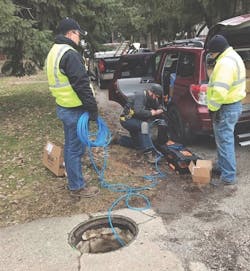Real-Time Data Informs Infiltration Study
About the author:
In-Situ Inc.
www.in-situ.com | 800.446.7488
When clean water infiltrates sewer pipes, the source can be tough to discern, especially in older systems susceptible to storm water and groundwater intrusion. This is the case in northeast Ohio, where residential and commercial users bring in more than 5 million gal per day (mgd) for treatment across a 17-sq-mile area, with more than 112 miles of collection line.
Dayton, Ohio-based Lower 48 Instruments was hired to measure the source of infiltration and correlate the magnitude of increase with local rainfall—information cities will use to plan repair projects and maintain U.S. EPA compliance. Lower 48 member Chris Davis and his team only had two days to complete meter installation and faced multiple installation challenges, from hazardous manholes dating back to the 1930s to improper invert construction that necessitated minor demolition of concrete.
The team deployed 16 area-velocity sensors and rain gauges connected to In-Situ Mace FloPro XCi and HVFlo XCi monitoring systems.
Those devices tied into In-Situ’s telemetry and HydroVu data services for data acquisition in near-real time. Solar panels in remote locations and batteries in city locations were used to pro- vide power for up to 30 days at a time.
“We needed that real-time access to data so we could react when a rain event occurred and not after the fact,” Davis said.
Collected data has enabled county person- nel to locate a 1-mile-long stretch of pipe expe- riencing heavy infiltration.
“Because the Mace sensors continuously see across the entire cross section of pipe instead of a pinpoint or a few points at a time, we can tune it to give our clients a true flow reading they can trust,” Davis said.
While the final project is years away from completion, the installation will help save tax- payers tens of millions of dollars in construction costs for a new plant.


